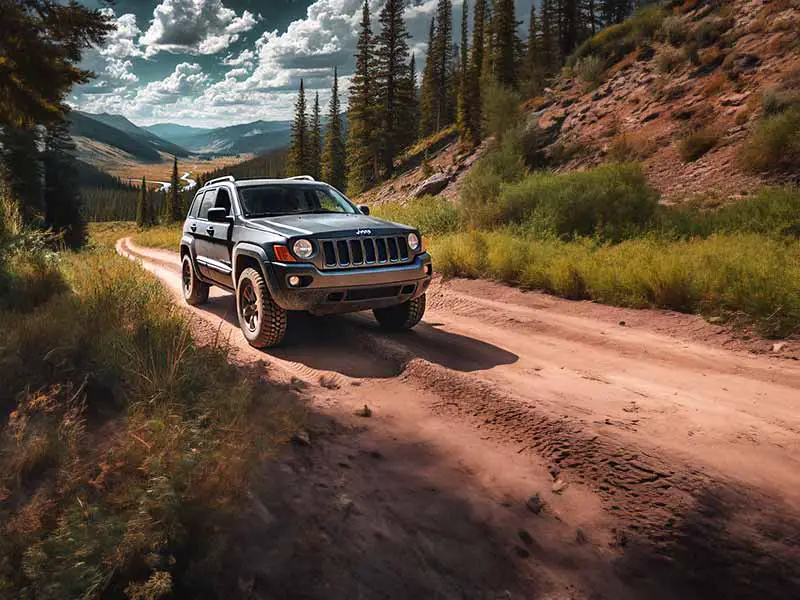Ever found yourself confused when someone talks about wheels, tires, and rims as if they’re the same thing? You’re not alone! Understanding these terms is not just for car enthusiasts; it’s crucial for anyone who drives. Get ready to become the go-to person for all things wheels and tires!
Difference Between Wheels And Tires
The difference between wheels and tires (and rims) is that a wheel is the metal framework that serves as the foundation for the tire, which is the rubber component that makes contact with the road. The rim is the outer edge of the wheel that holds the tire in place.
In this article, we’ll dive deep into the differences between wheels, tires, and rims, and debunk common misconceptions.
Let’s take a closer look.
What is a Wheel?
A wheel is a round object that rotates around a central axis, allowing for smooth movement of a vehicle. In the context of passenger cars and trucks, a wheel is not just the round metal you see but is a complex assembly of various parts.
Components of a Wheel Assembly
Understanding a wheel requires knowing its different components. A wheel assembly typically consists of:
- Hub: The central part that connects the wheel to the axle.
- Spokes: These are rods or bars extending from the hub to the wheel’s outer edge.
- Rim: The outer circle of the wheel where the tire mounts onto.
- Lug Nuts: Small, but strong, nuts that secure the wheel to the vehicle.
It’s crucial to note that the tire is not part of the wheel assembly; it’s a separate component that fits around the wheel.
Are Tires Called Wheels?
A common misconception is that the terms “tire” and “wheel” are interchangeable. They are not. The wheel is the metal framework, and the tire is the rubber casing that goes around it. The tire makes direct contact with the road, while the wheel serves as the foundation for the tire.
Function of a Wheel
The primary function of a wheel is to provide a solid base for the tire. It bears the weight of the vehicle and its passengers, and it rotates to enable movement. Here’s how it works:
- Rotation: The wheel rotates around its hub, which is connected to the axle.
- Support: It supports the weight of the vehicle, distributing it evenly for a smooth ride.
- Connection: The wheel connects to the vehicle through lug nuts, ensuring it stays in place during movement.
Material and Construction
Wheels can be made from various materials, including steel, aluminum, and alloy. Each material has its pros and cons:
- Steel Wheels: Durable but heavy, often used in trucks.
- Aluminum Wheels: Lighter than steel and better for fuel efficiency.
- Alloy Wheels: A mixture of aluminum and other metals, offering a balance of strength and lightness.
Importance in Vehicle Safety
Wheels play a critical role in vehicle safety. A damaged or improperly installed wheel can lead to accidents. Therefore, regular inspection and maintenance are essential.
What is a Tire?
A tire is a rubber casing that fits around the wheel to provide grip, cushioning, and a smooth ride. Unlike the wheel, which is made of metal, the tire is primarily made of rubber and contains air or foam.
Components of a Tire
A tire is more than just a rubber circle; it has multiple layers and components that work together for optimal performance. These include:
- Tread: The outermost layer that makes contact with the road.
- Sidewall: The side of the tire that connects the tread to the bead.
- Bead: The inner edge of the tire that attaches to the wheel’s rim.
- Inner Liner: A layer inside the tire that holds the air, making the tire airtight.
Role of a Tire in a Vehicle
The tire serves several essential functions in a vehicle:
- Grip: It provides the necessary grip to move and stop the vehicle.
- Cushioning: The air or foam inside the tire acts as a cushion, absorbing shocks from the road.
- Support: While the wheel holds the weight of the vehicle, the tire distributes this weight across the road surface.
Types of Tires for Passenger Cars and Trucks
There are various types of tires, each designed for specific driving conditions:
- All-Season Tires: Good for most weather conditions but not extreme ones.
- Summer Tires: Designed for hot weather and dry roads.
- Winter Tires: Made for snowy and icy conditions.
- All-Terrain Tires: Suitable for both on-road and off-road driving, commonly used in trucks.
Are Tires Called Wheels?
It’s important to clarify that tires are not wheels. The tire is a separate component that fits around the wheel. While the wheel is the foundational structure, the tire is what allows the vehicle to interact with different road surfaces effectively.
Importance in Vehicle Safety
Just like wheels, tires are crucial for vehicle safety. Worn-out or damaged tires can lead to poor grip and control, increasing the risk of accidents. Regular inspection for wear and tear, as well as proper inflation, are key to maintaining tire health.
What is a Rim?
The rim is the outer edge of a wheel that holds the tire in place. While people often use the terms “wheel” and “rim” interchangeably, they are not the same. The rim is a part of the wheel, not the entire wheel itself.
Components of a Rim
A rim may look simple, but it has specific features that contribute to its function:
- Flange: The raised edge that helps keep the tire on the rim.
- Bead Seat: The area where the tire bead sits, ensuring a snug fit.
- Center Bore: The hole in the middle that fits over the wheel hub.
Do People Call Rims Wheels?
It’s a common misconception to call rims “wheels.” While the rim is a crucial part of the wheel assembly, it is not the whole wheel. The wheel includes other components like the hub and spokes, which are not part of the rim.
Function of a Rim
The rim has several important functions in a vehicle:
- Support: It supports the tire, ensuring it stays in place.
- Seal: The rim helps to create an airtight seal with the tire.
- Balance: A well-designed rim contributes to the overall balance of the wheel assembly, affecting the vehicle’s handling.
Material and Construction
Rims can be made from various materials, similar to wheels:
- Steel Rims: These are heavy but durable, often used in older models of cars and trucks.
- Alloy Rims: Made from a mixture of metals, these are lighter and offer better performance.
- Aluminum Rims: These are even lighter than alloy rims and are often used in modern passenger cars for better fuel efficiency.
Importance in Vehicle Safety
The condition of the rim can significantly impact vehicle safety. A damaged or bent rim can lead to tire failure or poor vehicle handling. Therefore, it’s essential to inspect your rims regularly and replace them if needed.

Wheel vs Tire
It’s crucial to understand that a wheel and a tire are two different components of a vehicle. While they work closely together, they have distinct functions, materials, and roles in vehicle safety and performance.
Key Differences
Here are some of the main differences between a wheel and a tire:
- Material: Wheels are typically made of metal (steel, aluminum, or alloy), while tires are made of rubber.
- Function: The wheel serves as the foundation for the tire, while the tire makes direct contact with the road.
- Components: A wheel includes the hub, spokes, and rim. A tire consists of the tread, sidewall, bead, and inner liner.
Why It’s Incorrect to Call a Tire a Wheel
One common mistake is using the terms “tire” and “wheel” interchangeably. This is incorrect for several reasons:
- Different Roles: The wheel provides structural support, while the tire provides grip and cushioning.
- Separate Maintenance: Wheels and tires require different types of care and maintenance.
- Different Lifespan: Tires wear out more quickly and need to be replaced more often than wheels.
How They Work Together
Though different, wheels and tires must work in harmony for a vehicle to function properly:
- Fit: The tire fits snugly around the wheel’s rim, creating an airtight seal.
- Rotation: The wheel rotates, allowing the tire to roll along the road.
- Support: The wheel supports the weight of the vehicle, while the tire distributes this weight on the road surface.
Importance in Vehicle Safety
Both wheels and tires play critical roles in vehicle safety:
- Wheels: A damaged wheel can lead to poor vehicle handling.
- Tires: Worn-out or underinflated tires can cause accidents due to poor grip.
Resources
Below are some links you may find helpful when learning about tires
- Difference between rims, wheels, and hubcaps – Discount Tire
- What is the difference between tires & wheels? – It Still Runs
Final Thoughts
Understanding the differences between wheels, tires, and rims is crucial for effective vehicle maintenance and safety. Wheels are the metal frameworks that provide a foundation for the rubber tires, which make contact with the road. Rims are the outer edges of wheels that hold the tires in place. Each has a unique role, and using the correct terminology can save you time, money, and potential safety risks.
Good luck and happy motoring.




